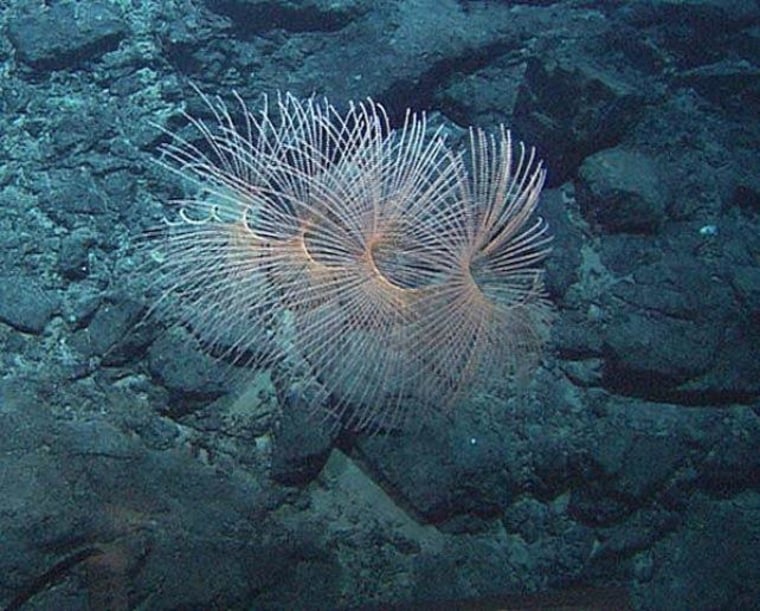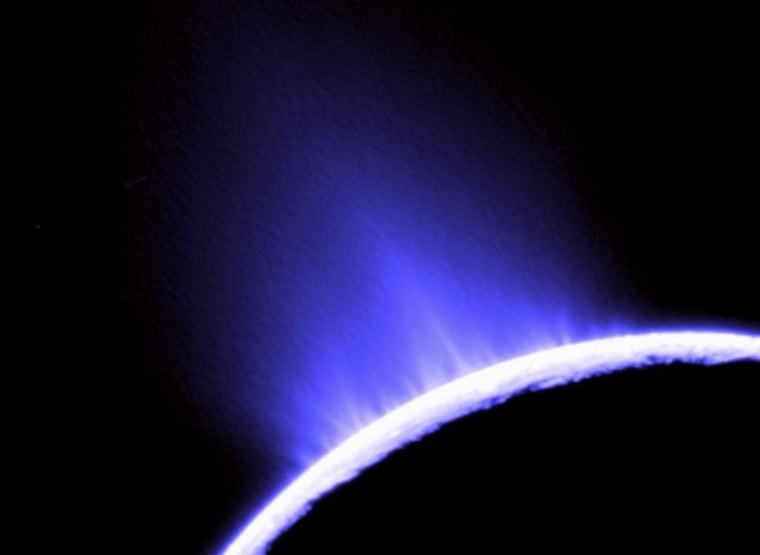Two studies suggest that a moon of Saturn called Enceladus has active hydrothermal vents at the bottom of an ice-covered sea — and that the heat from those vents warms the sea to a temperature that could sustain earthly life.
The studies add to Enceladus' appeal as a prime place to look for life elsewhere in the solar system.
"You have a habitat that could possibly harbor life," Linda Spilker, project scientist for NASA's Cassini mission to Saturn, told NBC News. "So it'd be very interesting to go back with a future mission to make the measurements to could tell you whether or not there might be life in Enceladus' ocean."
Scientists have not yet seen the hydrothermal vents at work, let alone any evidence of marine life. Enceladus' warm and toasty water is hidden under an icy crust that's as much as 25 miles (40 kilometers) thick. Nevertheless, the researchers behind the two studies say Earthlike volcanic vents would be the best explanation for the materials that the Cassini orbiter has detected spewing out from the moon's surface.
Nine years ago, the Cassini team reported that geysers of water ice were rising from Enceladus' surface — a phenomenon that suggested the existence of a liquid reservoir under the ice. Since then, scientists have conducted a detailed analysis to determine that the hidden sea lies beneath an area near the moon's south pole, and that the water emanates from cracks in the ice that have been nicknamed "tiger stripes."
Scientists also determined that the icy spray was contributing to Saturn's faint E-ring, so the Cassini team used an instrument called the Cosmic Dust Analyzer to study what exactly was in that spray. In addition to ice crystals, they found a surprising level of silicon-rich, nanometer-sized particles — bits of fine dust that appear to be made of silica.
"What we did first was just to know what these particles were, and by doing this, we started to think about how they formed," Hsiang-Wen Hsu, a researcher at the University of Colorado's Laboratory for Atmospheric and Space Physics, told NBC News.
After running a variety of tests, the scientists found that the only way they could make particles that fine with terrestrial rocks was to have the minerals interact with alkaline water at a temperature of at least 194 degrees Fahrenheit (90 degrees Celsius). The water also has to have a salinity of 4 percent or less.
Those just happen to be the conditions that exist at a field of hydrothermal vents on the bottom of the Atlantic Ocean, known as the Lost City, where volcanically heated water makes it possible for weird types of life to survive in a sunless ecosystem. "That is a very good analog to what we have," Hsu said.

The message from methane
The study conducted by Hsu and his colleagues is published in this week's issue of the journal Nature. Another study, accepted for publication in Geophysical Research Letters, lends further support to the hydrothermal hypothesis.
The second study, led by Alexis Bouquet of the Southwest Research Institute, analyzed the composition of the water plumes coming from Enceladus as registered by the Cassini orbiter's Ion and Neutral Mass Spectrometer. Researchers compared the observed levels of several gases in the plumes with computer models for the composition of subglacial lakes on Earth — and found that there was more methane in the plumes than the models predicted.
One explanation might be that trapped methane was somehow being released from Enceladus' ice, but the researchers had an alternate explanation: Hydrothermal vents could be "compensating by adding methane into the ocean," they said.

Spilker, who works at NASA's Jet Propulsion Laboratory, said the methane research was a "nice, complementary part of the story." Although researchers previously knew that water was rising up from the cracks in Enceladus' ice, they didn't know whether that water was ever warm enough to provide the energy needed for life. The silica dust and the excess methane are two big hints that hydrothermal vents are warming up the water, just as they do for deep-sea life on Earth.
"What's really striking is that this is the first time we've seen active hydrothermal vents outside of the seafloor on Earth," Spilker said.
Scientists say the vent activity is probably stimulated by the tidal flexing of Enceladus' interior as the moon orbits Saturn and interacts gravitationally with the ringed planet's other moons, particularly Dione.
Life on Enceladus? Stay tuned
The latest findings support the view that Enceladus has the "Big Three" requirements needed for life on Earth: liquid water, the chemical building blocks for organic activity, and an energy source in the form of hydrothermal heat. But does that mean there's life on Enceladus?
"That is the big question left to be answered," Hsu said.
He cautioned that there's still a chance other processes could explain the observations that Cassini made. "It is necessary to have a more systematic study to understand why this way works and the others do not," Hsu said.
And even if hydrothermal vents exist, there's still a chance that they don't stay active long enough for deep-sea life to endure on Enceladus. "For life, the conditions have to be stable for a long time. It's most likely that the activity on Enceladus is episodic," Hsu said.
Spilker said Cassini is due to sample the moon's water plumes one more time during a close flyby in October — but the probe doesn't carry the right instruments for detecting life. And it could be a long time before the next opportunity to visit Enceladus. The next priority for NASA's exploration of the outer planets is to send a probe on repeated flybys past Europa, an ice-covered moon of Jupiter.
Like Enceladus, Europa is thought to harbor a watery ocean beneath its ice — an ocean that might be much bigger than Enceladus' sea.
"It's very possible that the same things might be happening there," Spilker said.